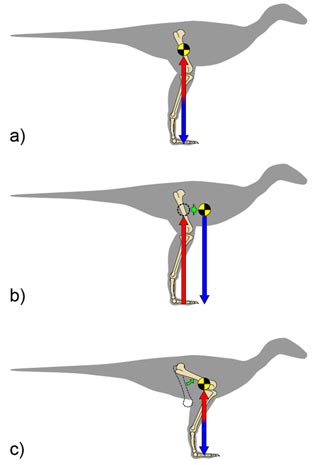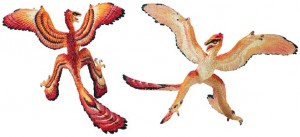Dinosaurs Out of Africa?
New Research Suggests Dinosaur Precursors Evolved in Africa
It is accepted by most scientists and academics that our species Homo sapiens first evolved in Africa. This continent has been referred to as the “cradle of mankind”, this is where the hominid lineage first evolved. New research suggests that those members of the archosaur group which were ancestral to the dinosaurs also evolved in Africa. Could this continent be referred to as the “cradle of the Dinosauria”?
“Cradle of the Dinosauria”
The American based research team including Christian Sidor, a biologist at the University of Washington and a research associate at the Field Museum of Natural History (Chicago, United States), set about examining the fossil record of Late Permian and Early Triassic vertebrates from five locations in the Southern Hemisphere. Their aim was to build up a picture of tetrapod life before the Permian mass extinction and to plot what happened to the different types of animals after the end of the Permian and to assess how animal life changed during the Early Triassic.
This was an arduous undertaking. The fossil record is relatively poor for this part of Earth’s long history and the pertinent fossil material for the study was to be found in many far flung museums and universities. The team studied recent fossil finds as well as specimens that had been held in collections for many years.
There is a strong body of evidence to suggest that the Dinosauria did evolve in the Southern Hemisphere (fossils from South America), but pinning down where the very first archosaurs on the road to becoming the Dinosauria, evolved was a much more exacting task.
Permian Mass Extinction Event
Around 250 million years ago (252.3 million years ago), our planet suffered a mass extinction event. It has been estimated that seventy percent of all terrestrial vertebrate life and ninety percent of all marine life became extinct. The seas lost most of the corals, entire reef ecosystems collapsed. The trilobites and other arthropods such as the sea scorpions died out and the likes of the sea lilies, brachiopods, bivalves and gastropods suffered huge losses. On land, some palaeontologists have estimated that some seventy percent of all vertebrate genera living on land vanished.
The causes of this extinction event, regarded as one of the “big five extinctions” of the Phanerozoic remain open to debate, but this scientific team were interested in mapping the consequences of the extinction event, not necessarily finding the cause.
Studying Fossils From Five Locations
Using the existing fossil record, terrestrial life in five locations, all part of the super-continent Pangea were mapped. The sites studied were located in Tanzania, Zambia, Malawi, South Africa (fossils from the famous Karoo Basin) and Antarctica. During the Permian and Triassic geological periods, Africa, South America, India, Australia, New Zealand and Antarctica were joined together to form one vast land mass (Pangea).
The research team found that the dominant herbivores prior to the end of the Permian were the dicynodonts. These were short-tailed, stocky reptiles (synapsids) with beaked jaws. These reptiles were part of a clade of reptiles that would eventually give rise to the mammals. Terrestrial ecosystems were dominated by the same sorts of reptiles across all five locations studied.
Animal diversity was similar in all five of the locations studied. However, as the scientists plotted the post-extinction fauna they discovered that over the ten million years or so after the Permian extinction the five locations had a much more diverse and varied vertebrate fauna.
Study Shows that Dicynodonts No Longer Dominated Terrestrial Ecosystems

A trio of Placerias models which are dicynodonts. The Placerias replica is great for creating Triassic dioramas.
For models and replicas of Permian and Triassic prehistoric animals: CollectA Age of Dinosaurs (Prehistoric Life Models).
Dicynodont Decline
The dicynodonts went into decline and by the end of the Triassic these types of creatures were extremely rare – “dead clades walking” as they have been referred to. Types of animal to be found in the fossil sediments of the Karoo Basin (pre-extinction), are not very common at all in younger strata such as that studied from Tanzania and Zambia.
The Early Triassic terrestrial faunas became increasingly dominated by the archosaurs, a clade of reptiles that includes crocodiles, pterosaurs (flying reptiles), dinosaurs and the dinosaurs descendants – birds. Christian Sidor and his colleagues commented on the array of different archosaurs present in the younger fossil bearing strata examined in this study. The Tanzania site has produced the fossils of Nyasasaurus parringtoni, a fast-running, bipedal reptile that might prove to be the oldest specimen of a dinosaur known to science. The fossils of N. parringtoni date from approximately 245-240 million years ago (Griesbachian to Early Anisian faunal stages).
Scientists remain uncertain as to whether the fossil material found is that of a true dinosaur, there are certainly anatomical characteristics in the fossilised bones of Nyasasaurus parringtoni that are synonymous with the dinosaurs. This reptile could be the first member of the Dinosauria, a basal dinosaur, known as a dinosauriform or a representative of a closely related archosaur group – the silesaurids. What is strongly indicated by this new study is that there is a seemingly different ecosystem in Tanzania than what is seen in the Karoo Basin fossil material.
To read an article about Nyasasaurus parringtoni: The Oldest Dinosaur?
Long-term Impact on Life on Earth
A mass extinction event such as the Permian event has had a long-term impact on life on Earth. Ten million years or so after the extinction, terrestrial life was very different from that which came before. The more homogeneous and broadly distributed Late Permian fauna had given way to a more diverse and varied fauna. Terrestrial vertebrates marginalised in the Late Permian were able to exploit the changes and diversify. The beneficiaries of the Permian mass extinction event led to the dominant terrestrial vertebrates for the rest of the Mesozoic. The age of the dinosaurs was ushered in.
Mass extinction events, in essence “wipe the slate clean”, animals once on the periphery of an ecosystem have an opportunity to exploit gaps in food chain that become vacated. This study shows that ten million years after the extinction event, places such as Tanzania may have given rise to the first of the dinosaurs. It seems that just like people, the dinosaurs may be “out of Africa”.














